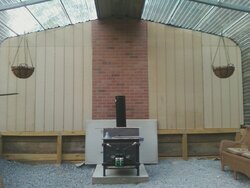I need some help with what I feel is a very basic installation that has me all confused.
I have the old FISHER wood stove that came out of my Pop's shop and wanted to install in my new greenhouse. I poured a pad and made sure I have 20 inches clear(18 required 20 better?) I have a 36" wide industrial metal roof panel 16 ga. at the roof (flat). The greenhouse is a used metal carport frame built up on a 4x4 wood frame, I have a 12 foot clear height floor to ceiling and approx 8 foot of single wall pipe to the underside of the metal panel. (see pic)
My thought and intent was to come off the stove into a 90 deg ell and with a single wall 8" pipe
straight up thru the roof, just like Pop did for years. simple , I thought.
I am having a hard time finding a 8" pipe boot (flashing) and a 8" cap. all I can find is 6" stuff.
The local hearth and fireplace stores I have called say what I want to do is not recommended?
why? Pop did it this way for years, no double wall pipe stuff or penetrations. then every single one I called start wanting to sell me a pellet stove, NO, I want to make Pops old stove work. Also I live in the upstate of South Carolina our winters are mild we on average have some days in the high 30's nights low 20's at worst.
Thank you in advance for any help and education and web sites to order what I need to make heat from Pops old stove. I made an attempt to attach the photo of the greenhouse.
BB
I have the old FISHER wood stove that came out of my Pop's shop and wanted to install in my new greenhouse. I poured a pad and made sure I have 20 inches clear(18 required 20 better?) I have a 36" wide industrial metal roof panel 16 ga. at the roof (flat). The greenhouse is a used metal carport frame built up on a 4x4 wood frame, I have a 12 foot clear height floor to ceiling and approx 8 foot of single wall pipe to the underside of the metal panel. (see pic)
My thought and intent was to come off the stove into a 90 deg ell and with a single wall 8" pipe
straight up thru the roof, just like Pop did for years. simple , I thought.
I am having a hard time finding a 8" pipe boot (flashing) and a 8" cap. all I can find is 6" stuff.
The local hearth and fireplace stores I have called say what I want to do is not recommended?
why? Pop did it this way for years, no double wall pipe stuff or penetrations. then every single one I called start wanting to sell me a pellet stove, NO, I want to make Pops old stove work. Also I live in the upstate of South Carolina our winters are mild we on average have some days in the high 30's nights low 20's at worst.
Thank you in advance for any help and education and web sites to order what I need to make heat from Pops old stove. I made an attempt to attach the photo of the greenhouse.
BB


